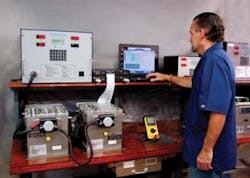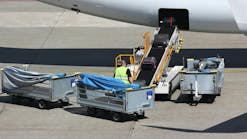Battery testing of aircraft nickel-cadmium batteries is a complex process but it doesn’t have to be complicated. The tests in themselves aren’t complicated but require strict attention to detail to ensure that the process will be accurate and efficient. In addition, for a successful performance, the process and equipment must result in accuracy and efficiency in the operation of the battery testing facility.
Types of tests
Battery testing focuses on two basic types of tests: charge acceptance and capacity.
Charge acceptance is the ability of the battery to convert input current into charge in the plates, as evidenced by voltages developed across each cell terminal and the overall battery voltage, each one within limits established by the manufacturers.
Capacity is the ability of the battery to deliver the rated current for a minimum time while the overall battery voltage and that of each individual cell remains above minimum set voltages.
Equipment
Battery performance testing requires exacting conditions of current, voltage, time, and temperature, hence, establishing the need for precision instrumentations.
The most important performance characteristic of the charger-analyzer for nickel-cadmium (NiCd) batteries is constant current because this is the best way to determine charge acceptance and capacity. Although other charge methods are mentioned by battery manufacturers, the only method that is fully described is constant current, hence, the method of choice.
Most NiCd batteries require a two-step constant current charging process. The first, called Main, is used to replenish the charge taken out during the capacity test and the second, called Topping, is to complete the charge and to test that each cell reaches the proper charge voltage. In addition, at the end of the topping charge period, the level of the electrolyte is verified and distilled water added as needed.
The equipment must also monitor the temperature of the battery during the charge process for nickel-cadmium cells must not develop any appreciable temperature increase.
Additional characteristics required of charger-analyzers include intuitive and user-friendly programming of the test parameters such as current, time, and battery voltage/number of cells, all with the necessary accuracy and stability for the validity of the tests.
When controls are easy to understand and use, training time is reduced and the chances of erroneous settings are also reduced. In addition, the equipment must be intrinsically safe for the protection of the operator, the battery, and the instrument itself.
Process
Testing procedures are well defined by manufacturers in their manuals and individual battery data sheets, so the only special requirement is the selection of the equipment to properly meet the test requirements.
Note that failing to observe proper testing requirements can and will result in premature failures and/or unnecessary replacement of batteries and cells, both having a significant impact in the cost of battery maintenance and in the operation of the aircraft. Improper battery maintenance can easily result in costly AOG situations and scary in-flight battery emergencies.
Battery testing is laborious because of the many steps that are required. From the readings taken to determine the “as received” condition, to the multiple cycles of charge and discharge required to restore the capacity of the cells, there is a requirement for a multiplicity of measurements and record keeping.
The most involved part of the testing is the multiple measurements that must be performed. For a typical 20-cell aircraft nickel-cadmium battery this means 20 measurements of cell voltages in addition to the total battery voltage for every step in the test process.
Although readings at the end of the charge and discharge tests constitute the bottom line for pass/fail determination, intermediate readings are useful because they provide early warnings of impending failures and/or they provide historical information that can be used to explain cell behavior.
Automating the process
Automating the process of measuring battery and cell voltages is definitely the best contributor for efficiency, for it alleviates the problem of time-consuming and error prone manual measurements and recording.
Automation of the charge/discharge process, on the other hand, is not as important because individually it is a lengthy process, particularly in the charge cycle which could take up to six hours per test. It would be desirable to achieve a total hands-off operation where the battery goes through its total testing on a “non-stop” basis. But, there are a variety of limitations. First of all, it is not possible to go from one test to another without reviewing the results. All cell readings, not just battery terminal voltage, must be evaluated (temperature included) to determine if the battery is ready for the next test. Depending on the readings, it may be necessary to replace one or more cells and/or alter the test process. In addition, a battery that has just completed a capacity test or total discharge will be hot and has to be allowed to cool down prior to recharging it. It is possible, however, to increase the efficiency of the charge/discharge process with equipment that can charge/discharge more than one battery at a time.
Cell measurement automation
Battery performance is dependent on the performance of each cell individually and not simply the sum total voltage measured at the battery terminals. Therefore, automation of the measurement of each of the cells is the basis for a battery analysis system. It ‘s not simply about automating one time readings but producing continuous readings throughout the tests.
Cell readings need to be automated not just simply to eliminate errors of manual readings but also to ensure that all measurements are taken at the same time. With manual measurements, from the first cell to the last cell, more than one minute can easily elapse. This is of particular importance during the capacity test because when cells are at the end of their discharge capacity, cell voltages will fall rather quickly, resulting in significant variations from the first cell to the last.
With cells that have ample reserve capacity this may not be important, but with marginal cells it can mean that the first cells being read may pass but the last ones may not resulting in an inaccurate picture of battery performance.
Continuous readings are also needed for a more complete test profile. Cells can fail at any time, during charge as well as during discharge. In the charge process, a failure of the cell separator can show up at any time by a drop in voltage with or without an increase in cell temperature. Visualizing this early in the test cycle, can simplify the analysis of the performance and reduce unnecessary testing.
Electronic storage of cell measurements
When data is recorded and not just printed as a one-time measurement, it is possible to develop a history for a particular battery that allows for comparison of tests performed throughout the life of the battery. Comparing a recent capacity test with a prior one can help determine the true health of the battery and can even be used to “predict” immediate and future needs for cell replacements.
It is a common practice to salvage “good” cells from several batteries and then assemble one “good” battery. To accomplish this, it is necessary to know the performance history of each cell so that some degree of matching can be achieved. With recorded data, it is possible to achieve this.
Finally, there is always the need for traceability and if data is archived electronically it makes it easier to retrieve.
The total solution
The total solution to achieving accuracy and efficiency in aircraft battery testing is to have an integrated system where the charger-analyzers are totally integrated and automated in parallel with the data acquisition and analysis system. Not having to continuously watch tests in progress allows for personnel to perform other tasks, knowing that when they come back to the battery shop all data will be taken and ready for analysis.
Battery testing can easily become a manageable task and not a nightmare. AMT
Joseph F. Mibelli, a graduate of the University of Miami with a BSEE degree, established JFM Engineering in 1978 to develop and manufacture precision equipment for aircraft battery testing. More information is available at www.jfmeng.com.





